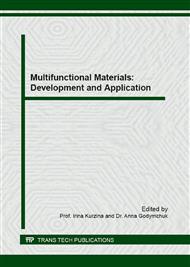[1]
E.A. Zy, A. Area, K. Aam, Antimicrobial activity of some medicinal plant extracts in Palestine, Pak. J. Med. Sci. 21 (2005) 187-193.
Google Scholar
[2]
J. Davies, D. Davies, Origins and evolution of antibiotic resistance, Microbiol. Mol. Biol. Rev. 74(3) (2010) 417-433.
DOI: 10.1128/mmbr.00016-10
Google Scholar
[3]
S.B. Levy, Antibiotic resistance, consequences of inaction, Clin. Infect. Dis. 33 (Supplement 3) (2001) 124-129.
Google Scholar
[4]
B. Spellberg, R. Guidos, D. Gilbert, J. Bradley, H.W. Boucher, W.M. Scheld, J.G. Bartlett, J. Edwards Jr, The infectious diseases society of America the epidemic of antibiotic-resistant infections, a call to action for the medical community from the infectious diseases society of America, Clin. Infect. Dis. 46 (2) (2008).
DOI: 10.1086/524891
Google Scholar
[5]
R.L. Finley, P. Collignon, D.G.J. Larsson, S.A. McEwen, X. -Z. Li, W.H. Gaze, R. Reid-Smith, M. Timinouni, D.W. Graham, E. Topp, The scourge of antibiotic resistance: the important role of the environment, Clin. Infect. Dis. 57 (5) (2013) 704-710.
DOI: 10.1093/cid/cit355
Google Scholar
[6]
European Centre for Disease Prevention and Control (ECDC), European Medicines Agency (EMEA), Joint technical report: the bacterial challenge. Time to react (ECDC–EMEA, Stockholm, 2009).
Google Scholar
[7]
M. Chen, Antimicrobial resistance in the European Union and the world, The EU's contributions to the solutions of the global antimicrobial resistance problem Keynote address at the conference on Combating antimicrobial resistance: time for action (Copenhagen, Denmark, 14 March 2012).
Google Scholar
[8]
Register of Medical Plants of Russia, fifth ed., Moscow, (1998).
Google Scholar
[9]
Yu.V. Shinkarenko, Secondary metabolites of representatives of family Boraginaceae Juss. in connection with the taxonomy and biological activity: thesis abstract, Novosibirsk, (2007).
Google Scholar
[10]
P.Y. Chunga, L.Y. Chunga, Y.F. Ngeow, S.H. Goh, Z. Imiyabir, Antimicrobial activities of Malaysian plant species, Pharm. Biol. 42 (2004) 292-300.
DOI: 10.1080/13880200490511837
Google Scholar
[11]
R. Nair, S.V. Chanda, Antibacterial activity of some medicinal plants of Saurashtra region, J. Tissue Res. 4 (2004) 117-120.
Google Scholar
[12]
H.J. De Boer, A. Kool, A. Broberg, W.R. Mziray, I. Hedberg, J.J. Levenfors, Antifungal and antibacterial activity of some herbal remedies from Tanzania, J. Ethnopharmacol. 96 (2005) 461-469.
DOI: 10.1016/j.jep.2004.09.035
Google Scholar
[13]
R. Nair, T. Kalariya, S. Chanda, Antibacterial activity of some selected Indian medicinal flora, Turk. J. Biol. 29 (2005) 41-47.
Google Scholar
[14]
I.N. Zilfikarov, V.A. Chelombit'ko, A.M. Aliev, Processing of Medicinal Plants Using Liquefied Gases and Supercritical Fluids, Pyatigorsk, (2007).
Google Scholar
[15]
E.F. Veslopolova, The micro-method of determine the number of colony-forming microorganisms, Microbiology. 64(2) (1995), 279-284.
Google Scholar
[16]
Determination of the sensitivity of microorganisms to antibiotics (Methodical instructions of MUK 4. 2. 1890-04), Clinical Microbiology Antimicrobial Chemotherapy. 6(4) (2004) 306-359.
Google Scholar
[17]
A.S. Labinskaya, Microbiology with the technique of microbiological tests, Medicine, (1978).
Google Scholar
[18]
A.V. Romanov, A.V. Dekhnich, M.V. Eidelstein, Molecular epidemiology of Staphylococcus aureus strains in children's hospitals of Russia, Clinical microbiological antimicrobial chemotherapy. 14 (3) (2012) 201-208.
Google Scholar
[19]
S.N. Rampersad, Multiple applications of Alamar Blue as an indicator of metabolic function and cellular health in cell viability bioassays, Sensors. 12 (2012) 12347-12360.
DOI: 10.3390/s120912347
Google Scholar
[20]
N.M. Makarchuk, Ya.S. Leshchinskaya, Yu.A. Akimov, Phytoncides in Medicine, Kiev, (1990).
Google Scholar
[21]
S.V. Sidorenko, The clinical significance of microbial resistance to antimicrobial agents, Russian medical lead. 1 (1998) 28-34.
Google Scholar
[22]
A.J. Vlietinck, L. van Hoof, J. Totte, A. Lasure, D. Vanden Berghe, P.C. Rwangabo, J. Mvukiyumwami, Screening of hundred Rwandese medicinal plants for antimicrobial and antiviral properties, J. Etyhnopharmacol. 46 (1995) 31-47.
DOI: 10.1016/0378-8741(95)01226-4
Google Scholar
[23]
T. Rabe, J. van Staden, Antibacterial activity of South African plants used for medicinal purposes, J. Ethnopharmacol. 56 (1997) 81-87.
DOI: 10.1016/s0378-8741(96)01515-2
Google Scholar


